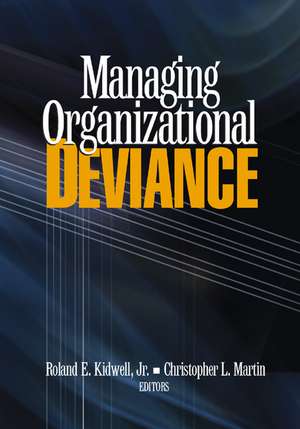Managing Organizational Deviance
Editat de Roland Kidwell, Christopher Lee Martinen Limba Engleză Paperback – 7 feb 2005
| Toate formatele și edițiile | Preț | Express |
|---|---|---|
| Paperback (1) | 729.81 lei 43-57 zile | |
| SAGE Publications – 7 feb 2005 | 729.81 lei 43-57 zile | |
| Hardback (1) | 1007.44 lei 43-57 zile | |
| SAGE Publications – 7 feb 2005 | 1007.44 lei 43-57 zile |
Preț: 729.81 lei
Preț vechi: 890.02 lei
-18% Nou
Puncte Express: 1095
Preț estimativ în valută:
139.69€ • 151.79$ • 117.42£
139.69€ • 151.79$ • 117.42£
Carte tipărită la comandă
Livrare economică 21 aprilie-05 mai
Preluare comenzi: 021 569.72.76
Specificații
ISBN-13: 9780761930143
ISBN-10: 0761930140
Pagini: 376
Dimensiuni: 178 x 254 x 20 mm
Greutate: 0.66 kg
Ediția:New.
Editura: SAGE Publications
Colecția Sage Publications, Inc
Locul publicării:Thousand Oaks, United States
ISBN-10: 0761930140
Pagini: 376
Dimensiuni: 178 x 254 x 20 mm
Greutate: 0.66 kg
Ediția:New.
Editura: SAGE Publications
Colecția Sage Publications, Inc
Locul publicării:Thousand Oaks, United States
Cuprins
CHAPTER 1. The Prevalence (and Ambiguity) of Deviant Behavior at Work: An Overview - Roland E. Kidwell Jr., & Christopher L. Martin
CASE 1.1. Columbia/HCA Health Care
CASE 1.2. The Undercover Operator - Anita Mancuso and Timothy O. Ireland
CHAPTER 2. Why Good Employees Make Unethical Decisions: The Role of Organizational Culture, Reward Systems and Managerial Oversight - Jennifer Dunn and Maurice E. Schweitzer
CASE 2. Sears Automotive
CHAPTER 3. The Role of Leaders in Influencing Unethical Behavior in the Workplace CHAPTER 3. The Role of Leaders in Influencing Unethical Behavior in the Workplace CHAPTER 3. The Role of Leaders in Influencing Unethical Behavior in the Workplace - Linda Klebe Treviño and Michael A. Brown
CASE 3. Bernard Ebbers: Innovative Leader or Reckless Risk Taker
CHAPTER 4. Badmouthing the Company: Bitter Employee or Concerned Corporate Citizen - Robert J. Bies and Thomas M. Tripp
CASE 4. Web Revenge on HealthSouth Corporation
CHAPTER 5. Withholding Effort at Work: Understanding and Preventing Shirking, Job Neglect, Social Loafing and Free Riding - Nathan Bennett and Stefanie E. Naumann
CASE 5. The Low-Quality Loafers
CHAPTER 6. Managing Noncompliance in the Workplace - Danielle E. Warren
CASE 6. Noncompliance at Dow Chemical
CHAPTER 7. The Difficulties of Telling the Truth at Work - Steven L. Grover
CASE 7.1. George O'Leary's Résumé
CASE 7.2. Janet Cooke and the Washington Post
CHAPTER 8: Bullying and Harassment in the Workplace - Gina Vega and Debra R. Comer
CASE 8. Kellie's Dilemma
CHAPTER 9. Discouraging Employee Theft by Managing Social Norms and Promoting Organizational Justice - Edward C. Tomlinson and Jerald Greenberg
CASE 9. The Purloined Password
CHAPTER 10. Managing Organizational Aggression - Mark J. Martinko, Scott C. Douglas, Paul Harvey, and Charles Joseph Mark J. Martinko, Scott C. Douglas, Paul Harvey, and Charles Joseph
CASE 10. Disney or Bust
CHAPTER 11. Addictive Behaviors in the Workplace - Paul Roman
CHAPTER 12. "I Deserve More 'Cause My Name's on the Door": Entitlement, Embededdness and Employee Deviance in the Family Business - Rebecca J. Bennett, Stefan Thau and Jay Scouten
CASE 12. Adelphia Communications and The Rigas Family
CHAPTER 13. Organizational Deviance and Culture: Oversights and Intentions - Linda Thorne and Joanne Jones
CASE 13. The Bob Smith Affair - Skye Susans and Alan J. Fish
CASE 1.1. Columbia/HCA Health Care
CASE 1.2. The Undercover Operator - Anita Mancuso and Timothy O. Ireland
CHAPTER 2. Why Good Employees Make Unethical Decisions: The Role of Organizational Culture, Reward Systems and Managerial Oversight - Jennifer Dunn and Maurice E. Schweitzer
CASE 2. Sears Automotive
CHAPTER 3. The Role of Leaders in Influencing Unethical Behavior in the Workplace CHAPTER 3. The Role of Leaders in Influencing Unethical Behavior in the Workplace CHAPTER 3. The Role of Leaders in Influencing Unethical Behavior in the Workplace - Linda Klebe Treviño and Michael A. Brown
CASE 3. Bernard Ebbers: Innovative Leader or Reckless Risk Taker
CHAPTER 4. Badmouthing the Company: Bitter Employee or Concerned Corporate Citizen - Robert J. Bies and Thomas M. Tripp
CASE 4. Web Revenge on HealthSouth Corporation
CHAPTER 5. Withholding Effort at Work: Understanding and Preventing Shirking, Job Neglect, Social Loafing and Free Riding - Nathan Bennett and Stefanie E. Naumann
CASE 5. The Low-Quality Loafers
CHAPTER 6. Managing Noncompliance in the Workplace - Danielle E. Warren
CASE 6. Noncompliance at Dow Chemical
CHAPTER 7. The Difficulties of Telling the Truth at Work - Steven L. Grover
CASE 7.1. George O'Leary's Résumé
CASE 7.2. Janet Cooke and the Washington Post
CHAPTER 8: Bullying and Harassment in the Workplace - Gina Vega and Debra R. Comer
CASE 8. Kellie's Dilemma
CHAPTER 9. Discouraging Employee Theft by Managing Social Norms and Promoting Organizational Justice - Edward C. Tomlinson and Jerald Greenberg
CASE 9. The Purloined Password
CHAPTER 10. Managing Organizational Aggression - Mark J. Martinko, Scott C. Douglas, Paul Harvey, and Charles Joseph Mark J. Martinko, Scott C. Douglas, Paul Harvey, and Charles Joseph
CASE 10. Disney or Bust
CHAPTER 11. Addictive Behaviors in the Workplace - Paul Roman
CHAPTER 12. "I Deserve More 'Cause My Name's on the Door": Entitlement, Embededdness and Employee Deviance in the Family Business - Rebecca J. Bennett, Stefan Thau and Jay Scouten
CASE 12. Adelphia Communications and The Rigas Family
CHAPTER 13. Organizational Deviance and Culture: Oversights and Intentions - Linda Thorne and Joanne Jones
CASE 13. The Bob Smith Affair - Skye Susans and Alan J. Fish
Descriere
The success of an organization may be dependent on limiting the potential for deviant behavior, and if necessary, reacting to deviant behavior in a positive way. Focusing on the successful management of deviant behavior in the workplace and the role of the organization in creating conditions for this behavior is a crucial topic of study for those interested in Organizational Behavior and Human Resource Management. Managing Organizational Deviance goes beyond questions of control to also consider ethical dimensions of conduct. As a result, it teaches students who will go on to inhabit organizations to become familiar with the ethical implications of deviant and dysfunctional behavior in addition to managing this behavior in an effective way.












